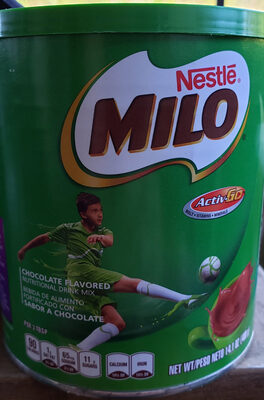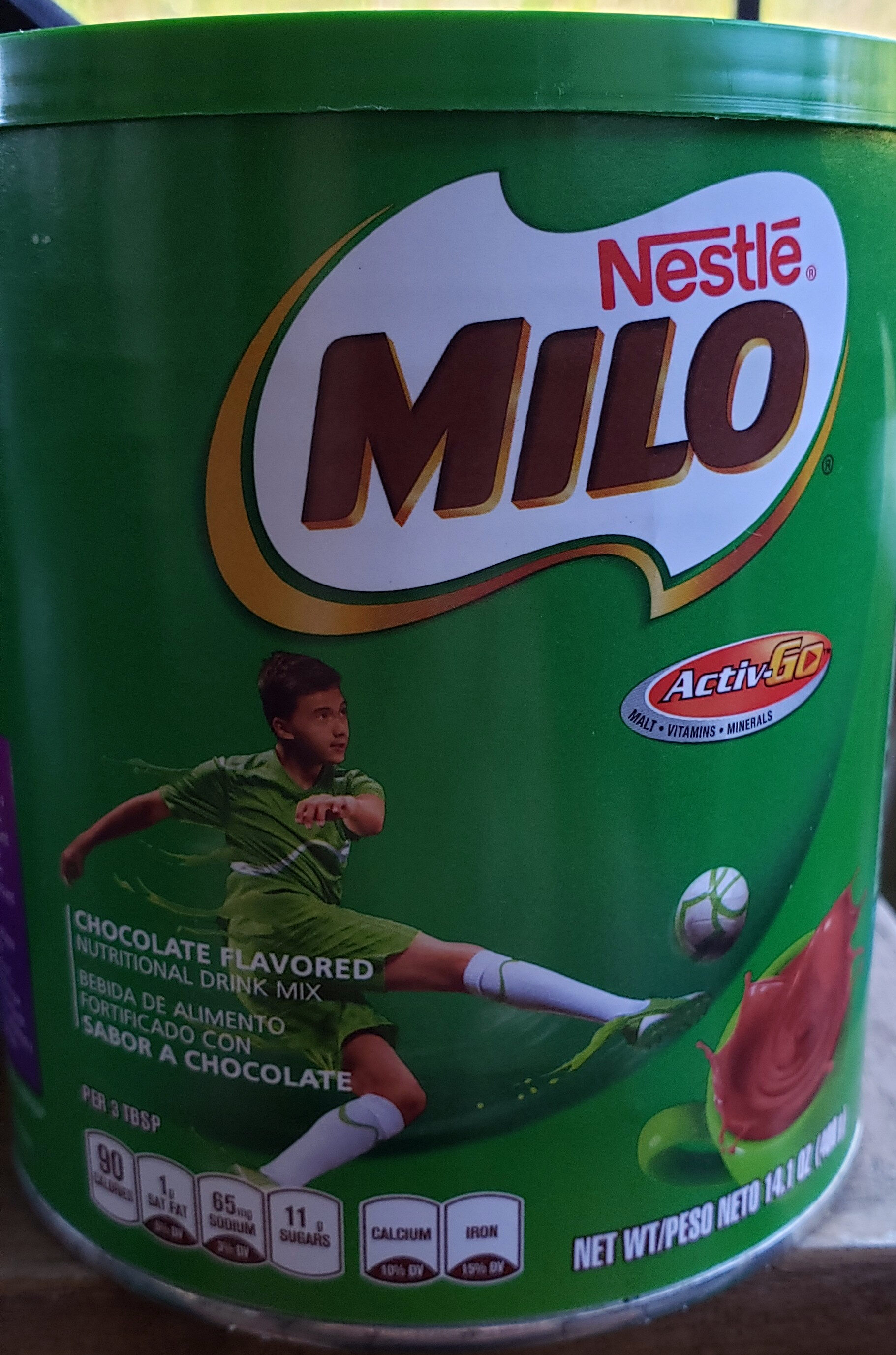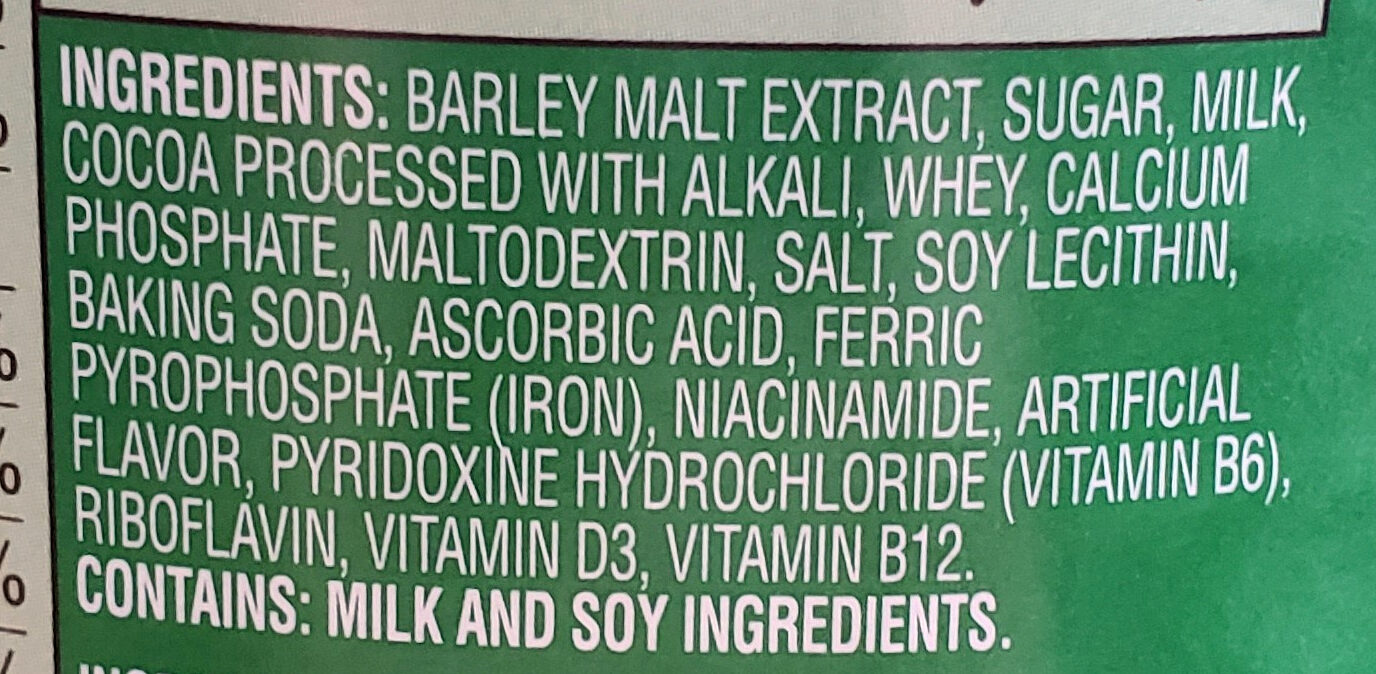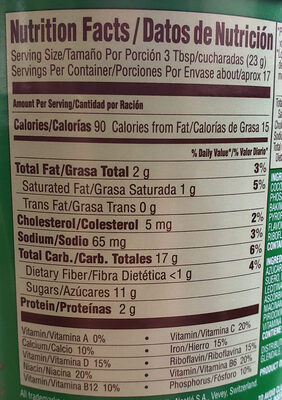Help us make food transparency the norm!
As a non-profit organization, we depend on your donations to continue informing consumers around the world about what they eat.
The food revolution starts with you!
Milo - Nestlé - 14.1 oz (400 g)
Milo - Nestlé - 14.1 oz (400 g)
This product page is not complete. You can help to complete it by editing it and adding more data from the photos we have, or by taking more photos using the app for Android or iPhone/iPad. Thank you!
×
Barcode: 0028000369712 (EAN / EAN-13) 028000369712 (UPC / UPC-A)
Common name: chocolate flavored nutritional drink mix.
Quantity: 14.1 oz (400 g)
Brand owner: Nestle USA Inc.
Categories: Plant-based foods and beverages, Beverages, Dairies, Plant-based foods, Cereals and potatoes, Dairy substitutes, Cereals and their products, Cocoa and its products, Milk substitutes, Plant-based beverages, Dairy drinks, Dried products, Plant-based milk alternatives, Dried products to be rehydrated, Flavoured milks, Cereal-based drinks, Chocolate milks, Cocoa and chocolate powders, Instant beverages, Non-alcoholic beverages, Dehydrated beverages, Barley-based drinks, Sweetened beverages
Origin of ingredients: Colombia
Manufacturing or processing places: Colombia
Traceability code: 080503190204
Link to the product page on the official site of the producer: https://www.nestle.com/
Stores: Walmart
Countries where sold: Bolivia, Philippines, United States
Matching with your preferences
Health
Ingredients
-
21 ingredients
BARLEY MALT EXTRACT, SUGAR, MILK, COCOA PROCESSED WITH ALKALI, WHEY, CALCIUM PHOSPHATE, MALTODEXTRIN, SALT, SOY LECITHIN, BAKING SODA, ASCORBIC ACID, FERRIC PYROPHOSPHATE (IRON), NIACINAMIDE, ARTIFICIAL FLAVOR, PYRIDOXINE HYDROCHLORIDE (VITAMIN B6), RIBOFLAVIN, VITAMIN D3, VITAMIN B12.Allergens: Gluten, Milk, Soybeans
Food processing
-
Ultra processed foods
Elements that indicate the product is in the 4 - Ultra processed food and drink products group:
- Additive: E322 - Lecithins
- Additive: E450 - Diphosphates
- Ingredient: Flavouring
- Ingredient: Maltodextrin
- Ingredient: Whey
Food products are classified into 4 groups according to their degree of processing:
- Unprocessed or minimally processed foods
- Processed culinary ingredients
- Processed foods
- Ultra processed foods
The determination of the group is based on the category of the product and on the ingredients it contains.
Additives
-
E322 - Lecithins
Lecithins are natural compounds commonly used in the food industry as emulsifiers and stabilizers.
Extracted from sources like soybeans and eggs, lecithins consist of phospholipids that enhance the mixing of oil and water, ensuring smooth textures in various products like chocolates, dressings, and baked goods.
They do not present any known health risks.
-
E322i - Lecithin
Lecithins are natural compounds commonly used in the food industry as emulsifiers and stabilizers.
Extracted from sources like soybeans and eggs, lecithins consist of phospholipids that enhance the mixing of oil and water, ensuring smooth textures in various products like chocolates, dressings, and baked goods.
They do not present any known health risks.
-
E341 - Calcium phosphates
Calcium phosphate: Calcium phosphate is a family of materials and minerals containing calcium ions -Ca2+- together with inorganic phosphate anions. Some so-called calcium phosphates contain oxide and hydroxide as well. They are white solids of nutritious value.Source: Wikipedia
-
E450 - Diphosphates
Diphosphates (E450) are food additives often utilized to modify the texture of products, acting as leavening agents in baking and preventing the coagulation of canned food.
These salts can stabilize whipped cream and are also found in powdered products to maintain their flow properties. They are commonly present in baked goods, processed meats, and soft drinks.
Derived from phosphoric acid, they're part of our daily phosphate intake, which often surpasses recommended levels due to the prevalence of phosphates in processed foods and drinks.
Excessive phosphate consumption is linked to health issues, such as impaired kidney function and weakened bone health. Though diphosphates are generally regarded as safe when consumed within established acceptable daily intakes, it's imperative to monitor overall phosphate consumption to maintain optimal health.
-
E500 - Sodium carbonates
Sodium carbonates (E500) are compounds commonly used in food preparation as leavening agents, helping baked goods rise by releasing carbon dioxide when they interact with acids.
Often found in baking soda, they regulate the pH of food, preventing it from becoming too acidic or too alkaline. In the culinary world, sodium carbonates can also enhance the texture and structure of foods, such as noodles, by modifying the gluten network.
Generally recognized as safe, sodium carbonates are non-toxic when consumed in typical amounts found in food.
-
E500ii - Sodium hydrogen carbonate
Sodium hydrogen carbonate, also known as E500ii, is a food additive commonly used as a leavening agent.
When added to recipes, it releases carbon dioxide gas upon exposure to heat or acids, causing dough to rise and resulting in a light, fluffy texture in baked goods.
It is generally recognized as safe (GRAS) by regulatory authorities when used in appropriate quantities and poses no significant health risks when consumed in typical food applications.
Ingredients analysis
-
Palm oil free
No ingredients containing palm oil detected
-
Non-vegan
Non-vegan ingredients: Milk, Whey
-
Vegetarian status unknown
Unrecognized ingredients: Ferric diphosphate, Iron, Vitamin b12
-
Details of the analysis of the ingredients
en: BARLEY MALT EXTRACT, SUGAR, MILK, COCOA PROCESSED WITH ALKALI, WHEY, CALCIUM PHOSPHATE, MALTODEXTRIN, SALT, SOY LECITHIN, BAKING SODA, ASCORBIC ACID, FERRIC PYROPHOSPHATE (IRON), NIACINAMIDE, ARTIFICIAL FLAVOR, PYRIDOXINE HYDROCHLORIDE (VITAMIN B6), RIBOFLAVIN, vitamins, vitamin D3, VITAMIN B12- BARLEY MALT EXTRACT -> en:barley-malt-extract - vegan: yes - vegetarian: yes - percent_min: 5.26315789473684 - percent_max: 100
- SUGAR -> en:sugar - vegan: yes - vegetarian: yes - ciqual_proxy_food_code: 31016 - percent_min: 0 - percent_max: 47.8
- MILK -> en:milk - vegan: no - vegetarian: yes - ciqual_proxy_food_code: 19051 - percent_min: 0 - percent_max: 33.3333333333333
- COCOA PROCESSED WITH ALKALI -> en:cocoa-processed-with-alkali - vegan: yes - vegetarian: yes - ciqual_proxy_food_code: 18100 - percent_min: 0 - percent_max: 25
- WHEY -> en:whey - vegan: no - vegetarian: maybe - percent_min: 0 - percent_max: 20
- CALCIUM PHOSPHATE -> en:e341 - vegan: yes - vegetarian: yes - percent_min: 0 - percent_max: 16.6666666666667
- MALTODEXTRIN -> en:maltodextrin - vegan: yes - vegetarian: yes - percent_min: 0 - percent_max: 14.2857142857143
- SALT -> en:salt - vegan: yes - vegetarian: yes - ciqual_food_code: 11058 - percent_min: 0 - percent_max: 0.707
- SOY LECITHIN -> en:soya-lecithin - vegan: yes - vegetarian: yes - ciqual_food_code: 42200 - percent_min: 0 - percent_max: 0.707
- BAKING SODA -> en:e500ii - vegan: yes - vegetarian: yes - percent_min: 0 - percent_max: 0.707
- ASCORBIC ACID -> en:e300 - vegan: yes - vegetarian: yes - percent_min: 0 - percent_max: 0.707
- FERRIC PYROPHOSPHATE -> en:ferric-diphosphate - percent_min: 0 - percent_max: 0.707
- IRON -> en:iron - percent_min: 0 - percent_max: 0.707
- NIACINAMIDE -> en:e375 - vegan: maybe - vegetarian: maybe - percent_min: 0 - percent_max: 0.707
- ARTIFICIAL FLAVOR -> en:artificial-flavouring - vegan: maybe - vegetarian: maybe - percent_min: 0 - percent_max: 0.707
- PYRIDOXINE HYDROCHLORIDE -> en:pyridoxine-hydrochloride - vegan: yes - vegetarian: yes - percent_min: 0 - percent_max: 0.707
- VITAMIN B6 -> en:vitamin-b6 - vegan: yes - vegetarian: yes - percent_min: 0 - percent_max: 0.707
- RIBOFLAVIN -> en:e101 - vegan: maybe - vegetarian: yes - percent_min: 0 - percent_max: 0.707
- vitamins -> en:vitamins - vegan: yes - vegetarian: yes - percent_min: 0 - percent_max: 0.707
- vitamin D3 -> en:cholecalciferol - vegan: maybe - vegetarian: maybe - percent_min: 0 - percent_max: 0.707
- VITAMIN B12 -> en:vitamin-b12 - percent_min: 0 - percent_max: 0.707
-
Nutrition facts
Nutrition facts As sold
for 100 g / 100 mlAs sold
per serving (3 tbsp/cucharada 23 g)Compared to: Barley-based drinks Energy 1,640 kj
(391 kcal)377 kj
(90 kcal)+97% Energy from fat 274 kj
(65 kcal)63 kj
(15 kcal)Fat 8.7 g 2 g +1,283% Saturated fat 4.35 g 1 g +2,800% Trans fat 0 g 0 g Cholesterol 21.7 mg 5 mg Carbohydrates 73.9 g 17 g +83% Sugars 47.8 g 11 g +860% Fiber < 4.35 g < 1 g Proteins 8.7 g 2 g +160% Salt 0.707 g 0.162 g +623% Vitamin A 0 µg 0 µg (0 % DV) Vitamin D 26.1 µg 6 µg (15 % DV) Vitamin C (ascorbic acid) 52.2 mg 12 mg (20 % DV) Vitamin B2 (Riboflavin) 0.37 mg 0.085 mg (5 % DV) Vitamin B3/PP (Niacin) 17.4 mg 4 mg (20 % DV) Vitamin B6 (Pyridoxin) 1.74 mg 0.4 mg (20 % DV) Vitamin B12 (cobalamin) 2.61 µg 0.6 µg (10 % DV) Calcium 435 mg 100 mg (10 % DV) Phosphorus 435 mg 100 mg (10 % DV) Iron 11.7 mg 2.7 mg (15 % DV) Fruits‚ vegetables‚ nuts and rapeseed‚ walnut and olive oils (estimate from ingredients list analysis) 0 % 0 %
Environment
-
Eco-Score E - Very high environmental impact
⚠ ️Select a country in order to include the full impact of transportation.The Eco-Score is an experimental score that summarizes the environmental impacts of food products.→ The Eco-Score was initially developped for France and it is being extended to other European countries. The Eco-Score formula is subject to change as it is regularly improved to make it more precise and better suited to each country.Life cycle analysis
-
Average impact of products of the same category: E (Score: 0/100)
Category: Cocoa or chocolate powder, for beverages, with sugar, fortified with vitamins and chemical elements, non rehydrated
- PEF environmental score: 1.32 (the lower the score, the lower the impact)
- including impact on climate change: 27.48 kg CO2 eq/kg of product
Stage Impact Agriculture
29.8 %Processing
62.5 %Packaging
3.8 %Transportation
3.6 %Distribution
0.3 %Consumption
0.0 %
Bonuses and maluses
-
Origins of ingredients with a high impact
Malus: -3
Environmental policy: -3
Transportation: 0
Origin of the product and/or its ingredients % of ingredients Impact Colombia 100 %High
-
Packaging with a medium impact
Malus: -12
Shape Material Recycling Impact 1 Food can Metal High 1 Lid Plastic High 1 Label Paper Low ⚠ ️ The information about the packaging of this product is not sufficiently precise (exact shapes and materials of all components of the packaging).⚠ ️ For a more precise calculation of the Eco-Score, you can modify the product page and add them.
If you are the manufacturer of this product, you can send us the information with our free platform for producers.
Eco-Score for this product
-
Impact for this product: E (Score: -15/100)
Product: Milo - Nestlé - 14.1 oz (400 g)
Life cycle analysis score: 0
Sum of bonuses and maluses: -15
Final score: -15/100
-
Carbon footprint
-
Equal to driving 14.2 km in a petrol car
2748 g CO² per 100g of product
The carbon emission figure comes from ADEME's Agribalyse database, for the category: Cocoa or chocolate powder, for beverages, with sugar, fortified with vitamins and chemical elements, non rehydrated (Source: ADEME Agribalyse Database)
Stage Impact Agriculture
27.2 %Processing
69.3 %Packaging
1.7 %Transportation
1.7 %Distribution
0.1 %Consumption
0.0 %
Packaging
-
Packaging with a medium impact
-
Packaging parts
1 x Food can (Metal)
1 x Lid (Plastic)
1 x Label (Paper)
-
Packaging materials
Material % Packaging weight Packaging weight per 100 g of product Paper or cardboard Plastic Metal Total
-
Transportation
-
Origins of ingredients
Origins of ingredients with a high impact
Origin of the product and/or its ingredients % of ingredients Impact Colombia 100 %High
Report a problem
-
Incomplete or incorrect information?
Category, labels, ingredients, allergens, nutritional information, photos etc.
If the information does not match the information on the packaging, please complete or correct it. Open Food Facts is a collaborative database, and every contribution is useful for all.
Data sources
Product added on by openfoodfacts-contributors
Last edit of product page on by osay.
Product page also edited by 5m4u9, giovannib, org-database-usda.








